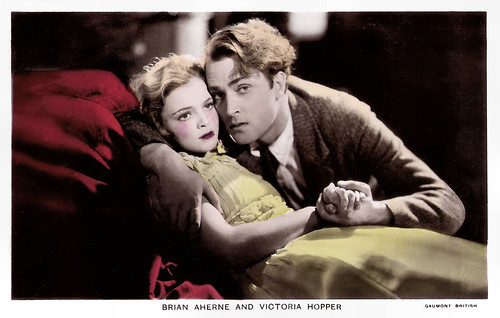
British Real Photograph postcard in the Film Partners series, no. P 121. Photo: Gaumont-British. Publicity still for The Constant Nymph (Basil Dean, 1933) with Victoria Hopper.
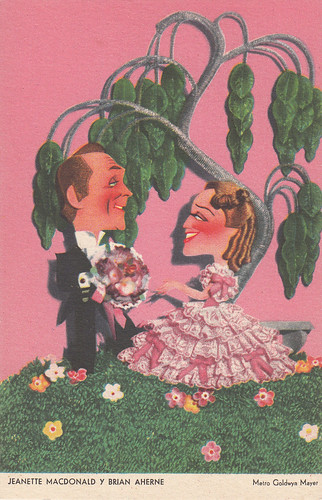
Spanish postcard by I.G. Viladot S/L, Barcelona. Caricature by Jacques Kapralik / Metro Goldwyn Mayer. Jeanette MacDonald and Brian Aherne. Collection: Marlene Pilaete.
The next best thing
Brian Aherne was born William Brian de Lacy Aherne in King's Norton, Worcestershire, England, in 1902. He was the son of the Birmingham architect William de Lacy Aherne and his wife Louise née Thomas. His brother was actor Patrick Aherne.
Brian was educated in Edgbaston, Birmingham, England and at Malvern College, Worcestershire. As a child, he trained at the Italia Conti's School in London, and at only 9, he made his stage debut in Birmingham. At age 18 he made his debut as an adult with the Pilgrim Players which would evolve into the famous Birmingham Repertory Theatre.
Three years later, he made his debut in London's West End. Then, Aherne studied architecture, but life as an actor was too strong to resist, so he returned to the theatre in 1923 for the revival of Paddy the Next Best Thing at the Savoy Theatre, London. For the next eight years, he toured the provinces and appeared in various productions in the West End.
In 1924, he made his film debut in the British crime drama The Eleventh Commandment (George A. Cooper, 1924) with Fay Compton, Stewart Rome and Lillian Hall-Davis. In the following years, he appeared in such films as the romantic dramas The Squire of Long Hadley (Sinclair Hill, 1925) and King of the Castle (Henry Edwards, 1925) both with Marjorie Hume.
In the comedy Safety First (Fred Paul, 1926), he played a man who has his friends pose as asylum inmates to fool his rich aunt. One of his best silent British films was Shooting Stars (Anthony Asquith, A.V. Bramble, 1928) in which his adulterous wife (Annette Benson) hatches a plot to kill him. Elissa Landi was his co-star in Underground (Anthony Asquith, 1928), a working-class love story set in and around the London Underground of the 1920s.

British Real Photograph postcard. Photo: Paramount.

British postcard in the Picturegoer Series, London, no. 401b. Photo: Paramount.
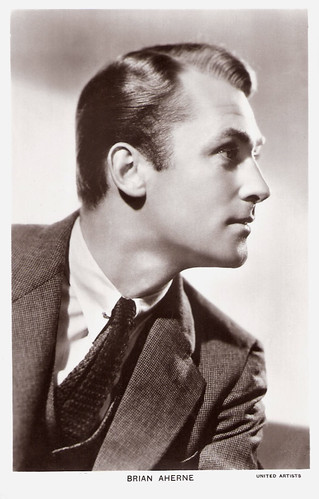
British Real Photograph postcard in the Picturegoer Series, no. 401 C. Photo: United Artists.

British Real Photograph postcard, no. 127. Photo: Metro-Goldwyn-Mayer.
A proper job
In 1931, Brian Aherne made his Broadway debut playing Robert Browning in The Barretts of Wimpole Street. His sound film debut was Madame Guillotine (1931). He alternated between the New York and London stages in the early 1930s. Then he moved to Hollywood. His first role was as Marlene Dietrich’s love interest in Song of Songs (Rouben Mamoulian, 1933). In Britain, he appeared in The Constant Nymph (Basil Dean, 1933).
He co-starred with Katharine Hepburn and Cary Grant in Sylvia Scarlett (George Cukor, 1935) and opposite Merle Oberon and David Niven in Beloved Enemy (H.C. Potter, 1936). Aherne embodied the legendary British stage actor David Garrick in James Whale’s The Great Garrick (1937) opposite the young Olivia de Havilland. Next, he made the romantic comedy Merrily We Live (Norman Z. MacLeod, 1938) in which he starred as an intelligent tramp hired as a chauffeur by a wealthy family.
In Juarez (William Dieterle, 1939) he played the doomed Emperor Maximillian. For this part, he was nominated for an Academy Award as Best Supporting Actor in 1940. During the 1940s he starred in popular films like the screwball comedy My Sister Eileen (Alexander Hall, 1942) with Rosalind Russell, and the entertaining propaganda film Forever and a Day (Edmund Goulding, Cedric Hardwicke, et al, 1943).
In 1945, he travelled to Italy, France, Holland, and Germany to perform for the troops in The Barretts of Wimpole Street. He returned to play supporting roles in Hollywood films as the Film Noir The Locke (John Brahm, 1946) starring Robert Mitchum, and Alfred Hitchcock’s thriller I Confess (1953) starring Montgomery Clift.
His final film was Rosie! (David Lowell Rich, 1967) in which he was reunited with Rosalind Russell. Brian Aherne published his autobiography A Proper Job in 1969, and 10 years later, he published a biography of his friend George Sanders, entitled A Dreadful Man. In 1986, Brian Aherne died of heart failure in Venice, Florida at the age of 83. He was married twice. His first wife was actress Joan Fontaine (1939-1945) (divorced). In 1946, he married Eleanor de Liagre Labrot, with whom he stayed till his death.
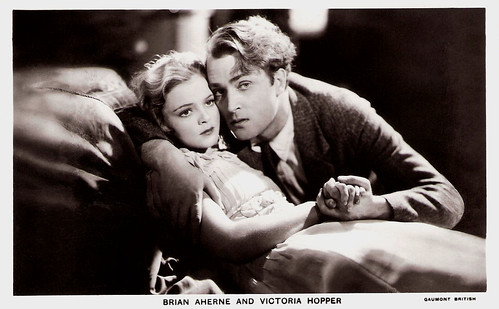
British Real Photograph postcard in the Film Partners series, no. P 121. Photo: Gaumont-British.Brian Aherne and Victoria Hopper in The Constant Nymph (Basil Dean, 1933).
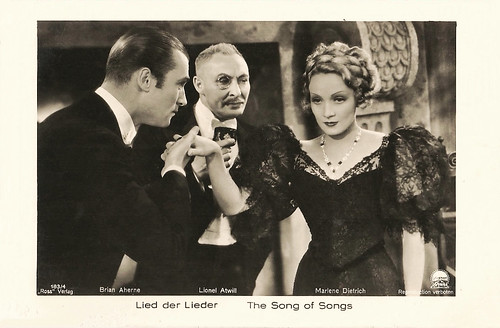
German postcard by Ross Verlag, no. 183/4. Photo: Paramount. Publicity still of Brian Aherne (Richard), Lionel Atwill (Baron von Merzbach) and Marlene Dietrich (Lily) in Song of Songs (Rouben Mamoulian, 1933). Dietrich is a naïve peasant girl who models (naked) for a sculptor and falls in love with him. A rich baron, the sculptor's client, presses the artist to leave the girl to him. The baron turns her into a lady, but, incidentally, in a world-wise woman too. He invites the sculptor to show Lily's metamorphosis. Lily is terribly hurt by both men.
Sources: Jon C. Hopwood (IMDb), Wikipedia, and IMDb.
This post was last updated on 10 April 2023.
No comments:
Post a Comment